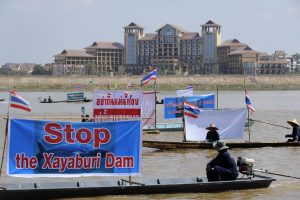As a struggling least developed country, Laos stands alone when it comes to ignoring common sense and pushing ahead with infrastructure development that it can ill-afford and is unlikely to deliver its much hoped-for rags to riches outcome.
Energy and Mines Minister Sinavav Souphanouvong made that clear when declaring that construction four highly contentious dams across the mainstream of the Mekong River would proceed despite a mountain of evidence detailing the potential damage to downstream countries.
Those four straddle the Mekong at Pak Beng, Luang Prabang, Pak Lay, and Sanakham, where officials are hoping to take advantage of demand for electricity from across the Thai border.
A fifth dam at Xayaburi began operations in late 2019.
Dwindling fish catches and food security for about 70 million people of the Lower Mekong Basin in Cambodia and Vietnam are the chief concerns of these projects.
But the justification – a decades-old argument that a cascade of dams will turn Laos into the “battery of Asia” and secure its financial future through hydro-power and electricity sales abroad – is also losing traction.
Last year the government was forced to cede control of its electricity grid to China Southern Power Grid Co as sovereign reserves fell to less than $1 billion amid the COVID-19 pandemic, compromising its ability to repay debt.
Thailand has signaled it may no longer simply buy as much power as Laos can generate and as unlikely as it sounds, competition is also likely to emerge from Australia over the coming decade.
It’s a dismal recipe, given that the cluster of five dams around Xayaburi will cost a total of about $12.5 billion, compared with Laos’s GDP of around $18 billion. Most of this cost was funded by debt owed to Chinese state banks and will eventually have to be repaid by ordinary Laotians.
Laos has consistently eschewed Western business interests in preference for like-minded Chinese developers and has not budged on environmental and fiscal concerns, nor has Vientiane catered for inevitable changes within the power market.
In northern Australia, the world’s largest solar power farm is under construction at a cost of $15 billion on a 10,000-square-kilometer property owned by the Packer family. Construction will begin in 2023, and energy production is expected in 2026 with exports to Singapore the following year.
Clean, politically-correct solar power is an obvious and easy choice for consumers concerned about the environmental damage normally associated with fossil fuels and dam construction.
An undersea cable will deliver the power to Singapore, which sits 3,350 kilometers from Darwin. Hooking up to mainland Southeast Asia should follow, through Malaysia and into Thailand where concerns over the plight of the Mekong are mounting in different directions.
One source close to the Mekong River Commission said that a less talked about concern was the enormous amount of sediment being held back by the cluster of five dams, and a lack of replenishment along the Mekong’s banks, which is damaging and threatening to alter the course of the river.
Thailand and Laos share an 850-kilometer border along the Mekong and any change in the river’s course would also result in a loss or gain in territory on either side, raising the prospect of an unwanted border dispute.
Souphanouvong also said 78 dams were now operational across the country and capable of producing 9,972 MW of electricity, adding that a total of 100 dams would be constructed by 2030. Many of those dams feed directly into the Mekong.
If Thailand was to lose ground by a change in the Mekong’s course then electricity sales from Laos would be objectionable and alternative sources welcomed. Others could follow suit and the unused “battery of Asia” would likely fall flat.
Luke Hunt can be followed on Twitter @lukeanthonyhunt

































